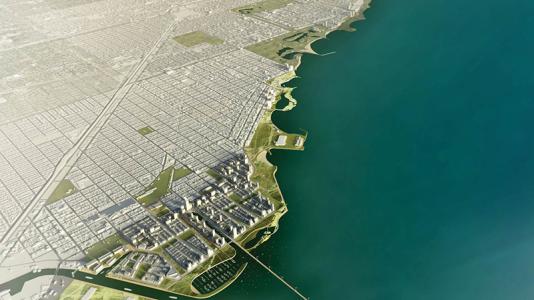
In 2010, the Chicago City Council granted initial approval for the Chicago Lakeside Development, a revitalization of a 600-acre site ten miles south of downtown that was formerly occupied by a U.S. steel plant. Vacant since the late 1970s, the Chicago Lakeside site is planned to eventually contain housing for 50,000 people, 17.5 million square feet of commercial and retail space, a new high school, a marina, 125 acres of public land, and new public transit service. The development will be financed with a roughly $4 billion combination of public and private funds.
Transforming the Lakeside site from an antiquated industrial plant to a modern, diverse urban neighborhood will rely heavily on data-driven approaches. “The unique opportunity and challenge of Chicago Lakeside is that it involves building a community more or less from scratch,” said Argonne computational scientist Charlie Catlett, who co-leads the Urban Center for Computation and Data, or UrbanCCD, one of the major partners in the development.
Argonne’s role in the initial planning of the Lakeside community involves studying and supporting what urban planners call “interdependencies” between the different parts of city infrastructure. “We want to improve our ability to understand, for instance, how traffic flow might be affected if we were to build a new high-rise office building on a particular street,” said Argonne energy policy scientist Leah Guzowski, who with Catlett has developed a new computational platform called LakeSim, which is expressly devoted to planning the community. “This requires us both to explore how we integrate existing tools into a common engine that would allow cross-communication as well as to identify new tools to fill critical gaps.”
By using big data to plan a new and ever-evolving community, UrbanCCD hopes to build a livable, sustainable, and efficient urban environment from scratch. “LakeSim is a new approach with strong potential to improve the way we design cities, and in turn the way we all live in and interact with cities,” Guzowski said. “This is a unique way of allowing us to think critically about how the city will look and function 30, 40, or 50 years from now. We know the decisions we make now will have a significant impact on the quality of future urban life.”
While Guzowski described the majority of Argonne’s work on the Lakeside development as still in its “proof of concept” stage, she explained that a data-driven approach to urban planning provides the analytics and science behind a more sustainable and livable city. “The world is currently experiencing a rapid shift toward urbanization, and we have to innovate and engineer our way to new ideas that will help us prepare for a whole host of new demands and consequences in the next few decades, especially for energy,” she said.
Read more about Argonne researchers involved in urban planning in City of the Big Data »
This story was originally published as a sidebar to “City of the Big Data” in volume 8, issue 1 of Argonne Now, the laboratory’s semiannual science magazine.